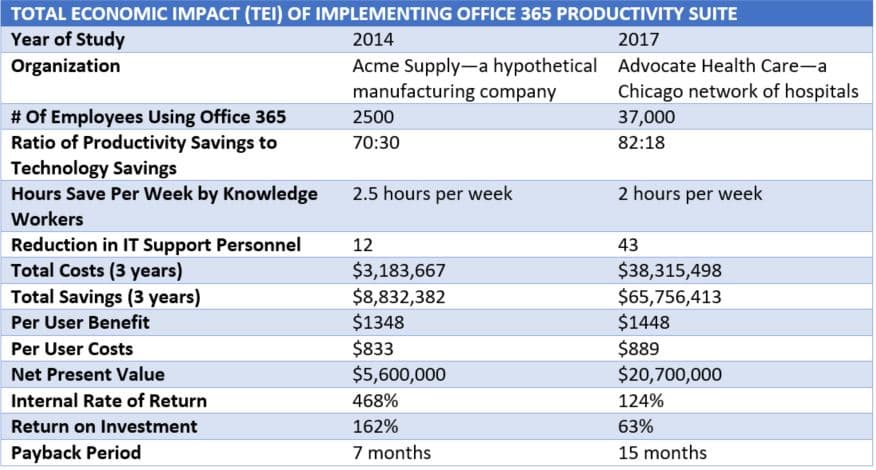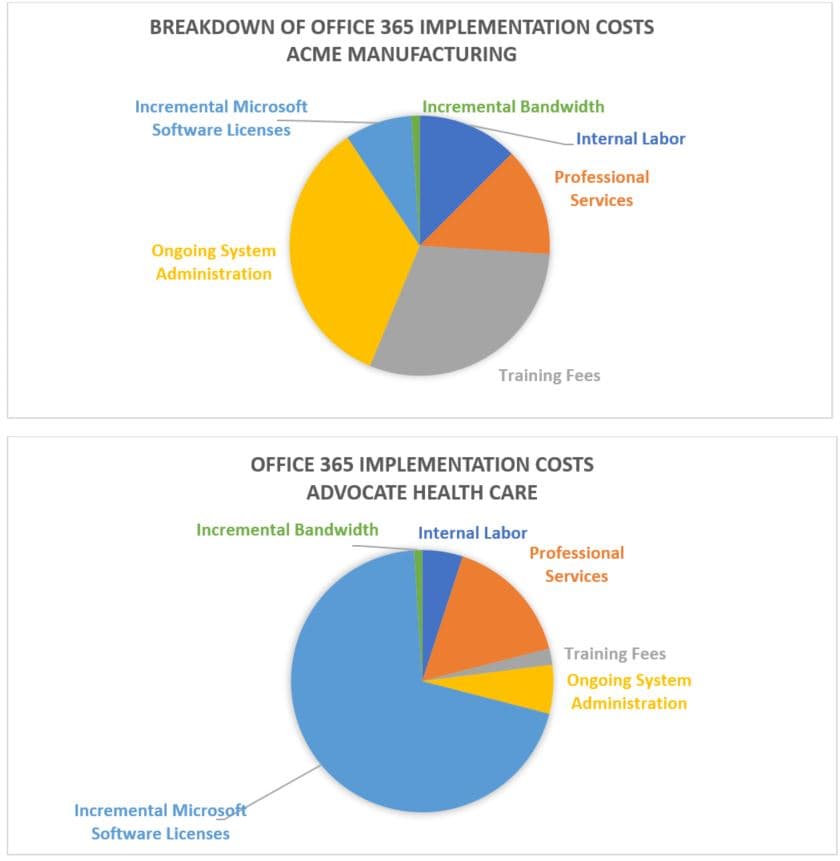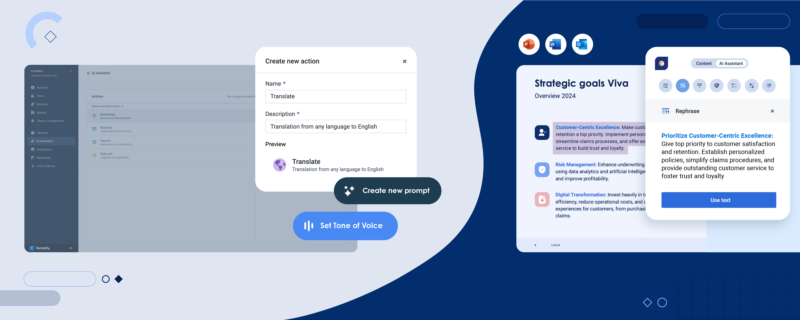Since its introduction in 2011, Microsoft Office 365 has emerged as a leading cloud-based solution for equipping employees with anytime, anywhere access to a full set of productivity tools. But how exactly will your organization benefit from the Office 365 productivity suite in terms of increased business performance? Less unnecessary travel? Reduced IT costs?
You can find answers to these questions in a series of in-depth reports on Office 365 productivity benefits by the IT consultant Forrester called Total Economic Impact™ (TEI) studies.
The Forrester TEI studies—each one 20-30 pages long—are based on extensive research on the behavior of actual users of the Office 365 productivity library combined with risk-adjusted estimates of costs and benefits that Forrester calculated using its proprietary TEI methodology. The result is one of the most complete pictures you will find anywhere of how your business could be enhanced by Office 365 cloud productivity.
Read next: What is Office 2019? Everything you need to know for now
For example, based on interviews with users, Forrester estimates how many hours a typical knowledge worker saves per week using the Office 365 productivity suite and then applies its TEI methodology to make a risk-adjusted estimate of the resulting financial savings over a three-year period. Forrester uses this same approach when looking at the impact on employee travel, outlays on hardware, IT supports costs, software licenses and more.
The result is both a financial and tactical roadmap to Office 365 productivity benefits that will be helpful to decision makers in IT, finance and individual business units. Along the way you will gain a wide range of Office 365 productivity tips while also getting insights into how a content management solution such as Templafy can take the benefits achieved in Office 365 to another level.
These Forrester TEI reports on Microsoft Office 365 productivity are available to anyone: the first report completed in 2014 is here and a second one from 2017 is here.
Consistent Benefits Across Manufacturing and Health Care
In developing its first TEI study of Office 365 productivity tools, Forrester relied on information gathered both in interviews and through an online user survey to create a composite picture of a hypothetical global manufacturer, Acme Supply Corporation, extending the Office 365 productivity suite to 2500 knowledge workers.
Forrester took an updated look at Office 365 cloud productivity in 2017, but this time focused on a single customer, Advocate Health Care, a network of hospitals in Chicago with 37,000 employees equipped with Office 365.
While the two organizations differ in what they do (manufacturing vs. health care) and size (2,500 vs. 37,000 knowledge workers) many of the findings were remarkably similar (See Table 1).
Existing Microsoft Users: Both the hypothetical manufacturer and Advocate Health Care were existing users of Microsoft Office applications, including Outlook and SharePoint, and saw the move to the Microsoft 365 cloud as a way to stay up to date with the latest technologies.
Productivity & Technology Savings: Both realized significant benefits by transitioning to the Office 365 productivity library—faster access to documents and tools, faster/improved decision making, higher productivity when working mobile—as well as savings in technology and IT support costs. The ratio of Office 365 productivity benefits to technology-related savings was 70:30 for the hypothetical manufacturer and 82:18 at Advocate Health Care.
Hours Saved Per Week: Actual time-savings by knowledge workers using Office 365 productivity tools were estimated at 2.5 hours per week per employee at Acme and 2 hours per week at Advocate Health Care. In addition, a smaller subset of mobile workers at Acme were estimated to save 5 hours per week. This was the single biggest Office 365 productivity benefit, generating savings of $6.2 million for the manufacturer and $53.9 million at Advocate Health Care.
Reduction in IT Support: The biggest technology-related benefit gained from the Office 365 productivity suite was Forrester’s calculation of the reduction in the amount of IT support staff required. In 2014, Forrester estimated that Acme would have needed a dozen additional administrators to handle the work of extending the same capabilities via on-premises software and servers. At Advocate, the reduction in IT support was estimated at 43 fewer administrators needed. This generated savings of $1.4 and $4.2 million respectively.
Per User Benefits and Costs: Again, although there were two very different organizations, per user benefits and costs were remarkably similar:
- The per user value of Office 365 cloud productivity was calculated at $1348 and $1448 respectively.
- The calculation of per-user costs of implementing the Office 365 productivity suite was even closer: $833 vs. $889.
Financial Return: Both analyses also indicated a healthy financial return, although the hypothetical manufacturer was deemed to have more robust IRR and ROI and a substantially faster payback than was projected for Advocate Health Care.
Table 1: Summary of Total Economic Impact (Risk adjusted over a 3-year period)

Additional Savings and Productivity Benefits of Implementing the Office 365 Productivity Suite
The Advocate 2017 study also reflects the greater role of Skype for Business and analytical tools such as Power BI and Excel Online—capabilities that were not available or not as well integrated into the Office 365 productivity library when Forrester did its first study in 2014:
- With Skype for Business, Advocate is conducting more meetings online, reducing employee travel and saving some $2.2 million over the three-year period.
- Advocate estimates it has saved $3 million by getting better visibility into its procurement costs using analytical tools such as Power BI.
Implementation Costs of the Office 365 Productivity Suite
On the cost side of the ledger, Forrester estimated what would be required to implement the Office 365 productivity suite in terms of labor, professional services, training, etc. While the overall costs per user were quite similar, the breakdown of costs was different between the two organizations.
Being much larger, Advocate Health Care benefited from economies of scale in areas such as training and system administration in which an outlay for comparable resources (i.e., x number of trainers over a three-year period) is amortized over a much larger user base.
On the other hand, because there were so many more employees using the different Office 365 productivity tools, Advocate’s fees for software licenses were much higher as an overall percentage of the total.

How Templafy Takes Office 365 Benefits to the Next Level
Microsoft began assembling its library of Office applications—Word, Excel, PowerPoint, Outlook, etc.—in the 1980s. Now by delivering cloud-based access to these applications, Office 365 is expected to solidify Microsoft’s position as a leading provider of productivity software. Microsoft CEO Satya Nadella told a technology conference earlier this year that the company could grow more from the Microsoft Office 365 cloud than anything in its 43-year history.
How does an Enterprise Content Management and document automation solution such as Templafy amplify and extend the already significant savings from Office 365?
Templafy does it by providing a way for large organizations to manage both the appearance and the content of the thousands of business documents that are generated each day, saving users time in document creation, protecting the brand, handling compliance issues, and much more.
Templafy enables an organization to maintain a central, cloud-based library of up-to-date digital assets—such as document templates, logos, slides, photographs, illustrations and text elements—and then simplifies and personalizes their distribution across your organization.
For example, email is a key way employees communicate with customers and each other—it’s the most heavily used application in the Office 365 productivity library. Templafy establishes the appropriate templates for email communication and then automatically and dynamically personalizes those templates for each employee. When an employee launches Outlook, Templafy automatically takes care of:
- The formatting of the email—putting in place the latest logos, fonts, text alignment and more.
- The signature—Templafy integrates directly with Active Directory to automatically insert the employee’s name, title and contact information into a correctly formatted signature.
- Any required legal disclaimers—ensuring that the right disclaimer is used by the right employee
- When revisions are needed—to the format, the logo, the disclaimer text—Templafy provides a single administration platform to make the changes and roll them out across your organization.
- Templafy provides these same capabilities for other Office 365 applications such as Word, PowerPoint and Excel.
For example, many organizations use an array of PowerPoint templates with different layouts, graphics, images, etc. adapted to different business units, product lines or geographic regions. Yet, they still need to stay on-brand.
Templafy organizes all of this and makes the correct elements available to each user as soon as the user launches PowerPoint. No hunting around for the right material or accidentally using an element incorrectly.
The same is true for documents produced in Word or Excel—offer letters, contracts, budgets, sales proposals and more. Templafy ensures that the correct templates, graphics and text elements are all used properly.
Templafy integrates seamlessly with the full set of Office 365 productivity tools—it appears as a task pane inside your Office applications. There is no jumping around between different windows—everything is right there.




